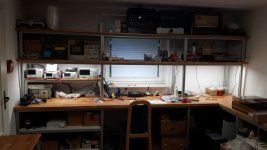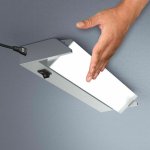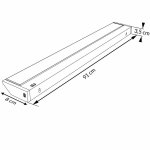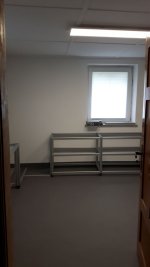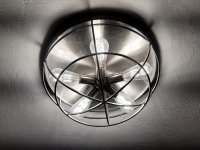I don't have a dedicated electronics workshop, but I have just fitted standard 12v Osram LED downlamps, designed for in ceiling fitment, in my storage shed running off recycled 12v car batteries (taken from our own cars) and a 70w monocrystalline solar panel. They just hang from a makeshift harness cobbled together around the tin roof. It is fused!
I have a fixture that I use to light up the assembly bench which uses two 40W PL-L lamps. The fixture I got from a surplus supplier, I changed the ballast since it was humming to an electronic ballast that I had left over when I was in the lighting industry.
PL-L is a tubular lamp featuring a specialist 2G11 single ended base that is rated between 18W and 80 Watts.
PL-L is a tubular lamp featuring a specialist 2G11 single ended base that is rated between 18W and 80 Watts.
I used to be an involved Photo aficionado back in the day, and the best Art Gallery illumination was a mix of:Some jewelry and dress shops here use a mix of 6500K and 2700K color temperature lamps for a more real rendering of colors.
- one daylight 40W fluo tube
- one "warm" 40W fluo tube
- one 75W standard tungsten filament lamp.
They mix very well and one covers the weaknesses of others.
If not possible, only 1 type allowed, there was a "warm white" tube made by Westinghouse, Osram, Philips which was quite neutral.
Nowadays of course we have all kinds of LED lamps.
Off topic, slightly:
Most of us have stopped using cameras and film, and use cell phones.
There are many apps which allow you to chamge the color rendering to a more neutral or real shade,
Most of us have stopped using cameras and film, and use cell phones.
There are many apps which allow you to chamge the color rendering to a more neutral or real shade,
Oh, one more thing...
There exist decorative LED adhesive strips with RGB LEDs, running off 12 V through a controller which allows you to tune the color and effect...
That should be useful.
There are also flood lights with the same type of construction, used for outdoor illumination, so those can be tried for exact color temperature...
Indoor versions may also be available.
There exist decorative LED adhesive strips with RGB LEDs, running off 12 V through a controller which allows you to tune the color and effect...
That should be useful.
There are also flood lights with the same type of construction, used for outdoor illumination, so those can be tried for exact color temperature...
Indoor versions may also be available.
Hi,
in my lab I use three tiltable LED lights mounted below the upper board of the desks.
They can be daisychained for reduced cabling, but feature an On-Off switch each.
This way there´s plenty of direct and diffuse light without blinding someone.
As major light source for the room serves a single 30x100cm large LED light panel.
jauu
Calvin
ps. notice the big red light switch to the left ;-)
In the meantime I mounted aside that switch a small casing with a big red emergency kill button on top (FRDs and all that stuff inside to switch off each phase separately and also added a fire extinguisher)
in my lab I use three tiltable LED lights mounted below the upper board of the desks.
They can be daisychained for reduced cabling, but feature an On-Off switch each.
This way there´s plenty of direct and diffuse light without blinding someone.
As major light source for the room serves a single 30x100cm large LED light panel.
jauu
Calvin
ps. notice the big red light switch to the left ;-)
In the meantime I mounted aside that switch a small casing with a big red emergency kill button on top (FRDs and all that stuff inside to switch off each phase separately and also added a fire extinguisher)
Attachments
The big disadvantage of those is they do not have an even spectrum but three (r-g-b) peaks, so the cri is very bad. R-g-b-w strips are probably better, there are also cold+warm white strips that can be tuned. Pure rgb strips may still be useful as additional effect lighting!RGB LEDs, running off 12 V through a controller which allows you to tune the color
R+G+B = W
C+M+Y+K is the control used in four color printing.
It was just a suggestion, an idea for those who are particular about the light level and color rendition.
C+M+Y+K is the control used in four color printing.
It was just a suggestion, an idea for those who are particular about the light level and color rendition.
True enough kelvin temp is important, but for my needs small spotlights at multiple angles serve me well. I cross their beams trying to leave less shadow if I get it just right.
It is your choice really, depending on how much work you do, and the kind of work you do.
The space and budget are also individual considerations.
I find that too bright a light, with reflections from the metal, to be uncomfortable.
So, your decision really, it is your space and your working style...
The space and budget are also individual considerations.
I find that too bright a light, with reflections from the metal, to be uncomfortable.
So, your decision really, it is your space and your working style...
True enough kelvin temp is important, but for my needs small spotlights at multiple angles serve me well. I cross their beams trying to leave less shadow if I get it just right.
Another of my hobbies is watch repair/servicing and for that I use two of those old fashioned multiple LED lamps that were battery operated and self adhesive like a puck, designed to go in a cupboard, with the bright spot from each of them coinciding at a 45 degree angle from each side to reduce shadows (mounted on a very makeshift stand). They're now powered by a wall wart. These are those lamps with about 12 or so 5mm standard LEDs in an array. It works quite well for a tightwad like me as they were never going to be used.
At least duplicate the color spectrum
I have a suspicion that too much blue spectrum light is messing with humans in many ways, physically and psychologically 🙂
I have a led plant light that is rich in red and blue, it’s really hard on the eyes but the plants love it
I have a suspicion that too much blue spectrum light is messing with humans in many ways, physically and psychologically 🙂
I have a led plant light that is rich in red and blue, it’s really hard on the eyes but the plants love it
Here is a hint, add in a sylvania T8 gro-lux into the mix of fluorescent lamps you have in your fixture.
Another hint, not all ballasts are the same, I use a high ballast factor (~18% more lamp current) instant start type.
I have one of above as a test sample ballast running for now ?15 years, changed the lamps once, Philips ALTO, good luck getting that performance out of a led, time will tell, my cfl's are now diying out
Another hint, not all ballasts are the same, I use a high ballast factor (~18% more lamp current) instant start type.
I have one of above as a test sample ballast running for now ?15 years, changed the lamps once, Philips ALTO, good luck getting that performance out of a led, time will tell, my cfl's are now diying out
Yes, i understand.It was just a suggestion, an idea for those who are particular about the light level and color rendition.
led strips with rgbw leds (red, green, blue and white) are quite common. you will find them doing a google search.
Those strips try to avoid the problem of additive rgb combining to apparent white.
The "problem" could be translated to acoustics, it's like trying to emulate white noise by playing only three single frequency tones.
Imagine an object having a color tone that reflects light of a specific wavelength. If none of the three led output wavelengths correspond to that specific color tone the object seems dark.
That translates to very low color rendition index (cri).
generally thermal radiators have an even light wavelength spectrum and have the highest cri.
I use a linear LED direct/indirect (DI) light by Nora. P/N: NLUD-4334. 6000+ lumen with various colour temperature options. I then have a desk lamp (<$10 from IKEA) with a 90+ CRI, 100 W equivalent LED bulb in it for task lighting. I have more photons than you can shake a stick at! 🙂
https://noralighting.com/product/nlud-4334/
Tom
https://noralighting.com/product/nlud-4334/
Tom
- Home
- Design & Build
- Equipment & Tools
- How do you "illuminate" your workshop?
